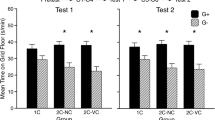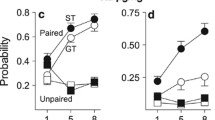Abstract
A novel version of the conditioned place preference (CPP) technique was used in an attempt to determine whether tactile stimuli previously associated with morphine elicit approach and sustained contact. Empirical support for this view has been equivocal, prompting some to question the validity of the CPP technique. In the present study, rats received, during conditioning, morphine (10 mg/kg, IP) paired exclusively with an open field floor made of four quadrants of one texture (CS+) and saline with another floor made of four quadrants of a different texture (CS−). On the test for CPP, rats were given saline and placed in an open field containing either 1, 2, or 4 quadrants of the CS+ (with 3, 2, 0 quadrants of the CS−, respectively). These animals showed high absolute CPP scores on the test, spending, on average, as much as 83% and 75% of their time on the CS+ when two and one CS+ quadrants, respectively, were present. Concurrent measures of activity indicated that animals were most active when all four quadrants were CS+ and least active when zero or one CS+ quadrant was present. Thus, once an animal approached and made contact with the CS+ it tended to maintain contact with this stimulus and to reduce its approach to and contact with other stimuli. The differentiating features of this version of the CPP technique, as well as the relationship between morphine-induced conditioned locomotion and CPP, are discussed.
Similar content being viewed by others
References
Amir S, Solomon M, Amit Z (1979) The effect of acute and chronic naloxone administration on motor activation in the rat. Neuropharmacology 18:171–173
Bardo MT, Miller JS, Neisewander JL (1984) Conditioned place preference with morphine: The effect of extinction training on the reinforcing CR. Pharmacol Biochem Behav 21:545–549
Beach HD (1957) Some effects of morphine on habit function. Can J Psychol 11:193–198
Bindra D (1968) Neuropsychological interpretation of the effects of drive and incentive-motivation on general activity and instrumental behavior. Psychol Rev 75:1–22
Bozarth MA (1987) Conditioned place preference: A parametric analysis using systemic heroin injections. In: Bozarth MA (ed) Methods of assessing the reinforcing properties of abused drugs. Springer, Berlin Heidelberg New York (in press)
Bozarth MA, Wise RA (1981) Heroin reward is dependent on a dopaminergic substrate. Life Sci 29:1881–1886
Hearst E, Jenkins HM (1974) Sign-tracking: The stimulus-reinforcer relation and directed action. The Psychonomic Society, Austin TX
Kamat KA, Dutta SN, Pradham SN (1974) Conditioning of morphine-induced enhancement of motor activity. Res Commun Chem Pathol Pharmacol 7:367–373
Katz RJ, Gormezano G (1979) A rapid and inexpensive technique for assessing the reinforcing effects of opiate drugs. Pharmacol Biochem Behav 11:231–233
Kirk RE (1968) Experimental design: Procedures for the behavioral sciences. Brooks/Cole Publishing Company, Belmont
Kumar R (1972) Morphine dependence in rats: Secondary reinforcement from environmental stimuli. Psychopharmacologia 25:332–338
Mucha RF, Herz A (1985) Motivational properties of kappa and mu opioid receptor agonists studied with place and taste preference conditioning. Psychopharmacology 86:274–280
Mucha RF, Iversen SD (1984) Reinforcing properties of morphine and naloxone revealed by conditioned place preference: A procedural examination. Psychopharmacology 82:241–247
Mucha RF, Volkovskis C, Kalant H (1981) Conditioned increases in locomotor activity produced with morphine as an unconditioned stimulus, and the relation of conditioning to acute morphine effect and tolerance. J Comp Physiol Psychol 95:351–362
Mucha RF, Van der Kooy D, O'Shaughnessy M, Bucenieks P (1982) Drug reinforcement studied by the use of place conditioning in rat. Brain Res 243:91–105
Perez-Cruet J (1976) Conditioning of striatal dopamine metabolism with methadone, morphine, or bulbocapnine as the unconditioned stimulus. Pavlov J Biol Sci 11:237–250
Phillips AG, LePiane FG (1980) Reinforcing effects of morphine microinjection into the ventral tegmental area. Pharmacol Biochem Behav 12:965–968
Rossi NA, Reid LD (1976) Affective states associated with morphine injections. Physiol Psychol 4:269–274
Schenk S, Ellison F, Hunt T, Amit Z (1985) An examination of heroin conditioning in preferred and nonpreferred environments and in differentially housed mature and immature rats. Pharmacol Biochem Behav 22:215–220
Sherman JE, Pickman C, Rice A, Liebeskind JV, Holman EW (1980) Rewarding and aversive effects of morphine: Temporal and pharmacological properties. Pharmacol Biochem Behav 13:501–505
Spyraki C, Fibiger HC, Phillips AG (1983) Attenuation of heroin reward in rats by disruption of the mesolimbic dopamine system. Psychopharmacology 79:278–283
Stewart J, Eikelboom R (1987) Conditioned drug effects. In: Iversen LL, Iversen SD, Snyder SH (eds) Handbook of psychopharmacology, vol 19. Plenum, New York (in press)
Swerdlow NR, Koob GF (1984) Restrained rats learn amphetamine-conditioned locomotion, but not place preference. Psychopharmacology 84: 163–166
Van der Kooy D (1987) Place conditioning: A simple and effective method for assessing the motivational properties of drugs. In: Bozarth MA (ed) Methods of assessing the reinforcing properties of abused drugs. Springer, Berlin Heidelberg New York Tokyo (in press)
Van der Kooy D, Mucha RF, O'Shaughnessy M, Bucenieks P (1982) Reinforcing effects of brain microinjections of morphine revealed by conditioned place preference. Brain Res 243:107–117
Vezina P, Stewart J (1984) Conditioning and place-specific sensitization of increases in activity induced by morphine in the VTA. Pharmacol Biochem Behav 20:925–934
White N, Sklar L, Amit Z (1977) The reinforcing action of morphine and its paradoxical side effect. Psychopharmacology 52:63–66
White NM, Messier C, Carr GD (1987) Operationalizing and measuring the organizing influence of drugs on behavior. In: Bozarth MA (ed) Methods of assessing the reinforcing properties of abused drugs. Springer, Berlin Heidelberg New York Tokyo (in press)
Young PT (1959) The role of affective processes in learning and motivation. Psychol Rev 66:104–125
Author information
Authors and Affiliations
Rights and permissions
About this article
Cite this article
Vezina, P., Stewart, J. Conditioned locomotion and place preference elicited by tactile cues paired exclusively with morphine in an open field. Psychopharmacology 91, 375–380 (1987). https://doi.org/10.1007/BF00518195
Received:
Revised:
Issue Date:
DOI: https://doi.org/10.1007/BF00518195




